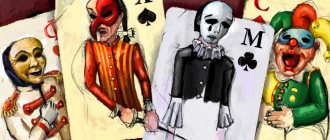History of the study and theory of temperament
V.M. Rusalov wrote: “The study of temperament has a complex and contradictory history. It is unlikely that there is such a fundamental concept in psychology that would be so well understood by everyone at the level of common sense, but in fact would be so little studied, despite the numerous publications devoted to it” [50]. To date, the situation has not changed: temperament is still one of the insufficiently studied mental phenomena.
Let us consider the main historical stages in the development of scientific ideas about human temperament.
Humoral theories of temperament . The concept of “temperament” arose on the basis of the teachings of the famous ancient Greek physician Hippocrates (VI-V centuries BC), according to which the level of vital activity of the body is determined by the relationship between the four fluids circulating in the human body - blood, bile, black bile and mucus ( lymph, phlegm). The ratio of these fluids varies from person to person.
It is from the theory of Hippocrates that the term “temperament” originates, coming from the Latin “temperamentum”, which translated means “proportionality, proper relationship of traits” [27, 30, 33].
Based on the teachings of Hippocrates, another famous physician of antiquity, Claudius Galen (2nd century BC), developed a typology of temperaments, which he outlined in the treatise “De temperamentum”. According to his teaching, the type of temperament depends on the predominance of one of the juices in the body. Depending on the hypothetical predominance of one of the juices, Galen identified and gave names to four types of human temperament: sanguine (from the Latin sanguis - blood), phlegmatic (from the German phlegma - mucus, phlegm), choleric (from the Greek chole - bile) and melancholic (from the Greek melas chole - black bile). For each type of temperament, Galen compiled a psychological portrait.
The concept of Hippocrates and Galen had a huge influence on scientists for several centuries, until the 19th century. Other scientists (Aristotle, Lesgaft, etc.) associated the characteristics of temperament with other features of the circulatory system - the speed of coagulation and blood density, the thickness and elasticity of the walls of blood vessels, the diameter of their lumen, the structure and shape of the heart [26, 33].
The last prominent representative of humoral theories of temperament is I. Kant, who in 1879 proposed semi-scientific, semi-artistic descriptions of temperament types, the organic basis of which he also considered the characteristics of blood.
Constitutional-typological theories of temperament . In 1921, the work of the German psychiatrist E. Kretschmer “Body Structure and Character” [21] was published, which presented a new look at the nature of temperament. Based on the results of clinical studies, Kretschmer linked human temperament with individual differences in physique - body shape, its proportions, height, weight, amount of body fat. According to Kretschmer, each specific human body type corresponds to certain psychological characteristics.
After taking many measurements of patients’ body parts, Kretschmer came to the conclusion that there are four human body types [17, 27]:
- Asthenic (leptosomal) (from the Greek asthenes - weak, leptos - fragile, soma - body) body type is characterized, first of all, by a combination of average height in height and weak height in width, which makes people of this type seem taller than they really are . His overall picture is of a thin man with narrow shoulders, thin arms and hands, a long and narrow chest, and a belly devoid of fat. The face of an asthenic person is usually long, narrow and pale; in the profile there is a sharp discrepancy between the elongated nose and the small lower jaw, and therefore it is called angular in shape.
- Pyknic (from the Greek pyknos - dense) is distinguished by the strong development of the internal cavities of the body (head, chest, abdomen) - with a weak motor system (shoulder girdle and limbs). Picnics are people of average height and with a dense figure, their deep sash chest goes into a massive, obese-prone abdomen, which is a kind of center of this body type (compared to the shoulder girdle of athletes). The frontal outline of the face resembles a pentagon (due to fat deposits on the lateral surfaces of the jaws), while the face itself is wide, soft, and rounded.
- The athletic (from the Greek athletes - wrestler) type is distinguished by the strong development of the skeleton and muscles, the width of the torso is significantly reduced downwards. People of this type have medium or tall height, broad shoulders, a stately chest, and an elastic stomach. The head of athletes is dense and high, it is supported directly on a strong, free neck, and the face usually has an elongated ovoid shape.
- Dysplastic (from the Greek dys - bad, plastis - formed) - characterized by a shapeless, irregular structure, various deformations of the physique (for example, excessive growth, disproportionate physique).
Each of the listed body types, according to Kretschmer, corresponds to a certain type of temperament:
- Schizothymic temperament corresponds to the asthenic (leptosomal) body type. Characterized by isolation to the point of autism, fluctuations in emotions from irritation to dryness, stubbornness, intractability to persuasion and change of attitudes, difficulties in adapting to the environment, and a tendency toward abstraction. With mental disorders, a predisposition to schizophrenia is detected.
- Cyclothymic – corresponds to the pyknic body type. It is characterized by qualities opposite to the characteristics of the schizothymic temperament: it easily contacts the environment, emotions fluctuate between joy and sadness, cheerfulness and gloom. In some cycloids, the center of these oscillations is directed towards the hypomanic pole, in others - towards the depressive pole. In mental disorders, a tendency towards manic-depressive psychosis is found.
- Ixothymic temperament – corresponds to the athletic type of temperament. An ixothymic person is calm, unimpressive, has restrained gestures and facial expressions, low flexibility of thinking, and has difficulty adapting to changes in the environment. In mental disorders, it shows a predisposition to epilepsy.
Kretschmer also identified four groups of qualities associated with human temperament:
- psychesthesia – excessive sensitivity or insensitivity to mental stimuli;
- mood background - a shade of pleasure or displeasure in mental experiences, noted on the cheerful-sad scale;
- mental tempo - acceleration or delay of mental processes in general and their special rhythm;
- general motor tempo - mobility or retardation, special nature of movements (fast, soft, rounded, etc.).
Kretschmer believed that the relationship between a person’s physique and temperament is due to the influence of the body’s endocrine system on both: “Temperaments..., as we firmly know empirically, are humorally determined by the chemistry of the blood. Their bodily representative is the apparatus of the brain and glands. Temperaments constitute that part of the psyche that, probably along the humoral path, is in correlation with the structure of the body. ... the brain remains the final organ for all actions related to temperament, even those that come from the chemistry of the blood. Experimental observations of brain injury indicate that direct effects on the brain can cause dramatic changes in temperament. This obvious fact should be especially emphasized so as not to fall again from anatomical one-sidedness into humoral one-sidedness, especially since with modern trends such a danger exists” [21].
Kretschmer's theory became widespread in Europe, and developed in the United States in the 1940s. the concept of temperament of the American doctor and psychologist W. Sheldon, similar to Kretschmer’s theory. Based on embryology on the one hand, and using specially developed photographic techniques and complex anthropometric measurements on the other, Sheldon came to the conclusion that human temperament depends on the predominant development of one of the three tissues originating from the three germinal petals of the embryo. In accordance with this, Sheldon identified three types of human body structure [17, 27, 36, 40]:
- Endomorphic (mainly internal organs are formed from the endoderm) - a relatively weak physique with excess adipose tissue - corresponds to the pyknic body type in the Kretschmer classification.
- Mesomorphic (muscle tissue is formed from the mesoderm) – a slender and strong body, great physical strength – corresponds to the athletic body type in Kretschmer’s typology.
- Ectomorphic (skin and nervous tissue develop from the ectoderm) - fragile physique, flat chest and long thin limbs with weak muscles - asthenic (leptosomal) type according to the Kretschmer classification.
Empirically, Sheldon discovered that the listed types of body structure correspond to certain types of temperament, to which he gave the following names [33, 50]:
- Viscerotonic (from Latin viscera - insides) - corresponds to the endomorphic body type. Characterized by a lively, sociable temperament, love of comfort, with sensual aspirations, relaxation and slow reactions.
- Somatotonic (from the Greek soma - body) - corresponds to the mesomorphic type of body structure. Characterized by a love of adventure, a penchant for risk and competition, a thirst for muscular action, activity, courage, and aggressiveness.
- Cerebrotonic (from Latin cerebrum - brain) - corresponds to the ectomorphic type of body structure. Characterized by a craving for aesthetic pleasures, coldness, low sociability, a tendency toward isolation and loneliness, and increased reactivity.
Thus, the theories of temperament of Kretschmer and Sheldon in general have a large number of similarities. However, both concepts have been criticized. The disadvantage of Kretschmer’s theory was seen in the fact that the data obtained on a group of mentally ill people were transferred to healthy people without sufficient grounds [37], and the disadvantage of both theories was considered the idea of “fatal somatic conditioning of a wide variety of mental personality traits, including such which are entirely determined by the conditions of upbringing and the social environment” [33].
Neurodynamic theories of temperament . A new approach to the study of temperament was developed in the 1920s and 1930s. outstanding Russian physiologist, Nobel Prize laureate I.P. Pavlov. Pavlov studied the higher nervous activity of living organisms, conducting numerous experiments on dogs. As a result of these experiments, he came to the conclusion that temperament is based not on the properties of fluids or bodily tissues, but on the peculiarities of the functioning of the nervous system, namely, the properties of the nervous processes of excitation and inhibition.
“Long-term laboratory observation,” writes I.P. Pavlov, and the study of a huge number of dogs using the method of conditioned reflexes gradually revealed to us these properties in their life manifestations and combinations. These properties are: firstly, the strength of the basic nervous processes - irritable and inhibitory - which constantly constitute integral nervous activity; secondly, the balance of these processes and, finally, thirdly, their mobility. It is obvious that all of them, being present simultaneously, determine the highest adaptation of the animal organism to the surrounding conditions of life, in other words, the perfect balance of the organism as a system with the external environment, i.e., they ensure the existence of the organism. The significance of the strength of the nervous processes is clear from the fact that in the environment there are (more or less often) unusual, extraordinary events, irritations of great strength, and, naturally, the need often arises to suppress, delay the effects of these irritations at the request of others, the same or even more powerful, external conditions. And nerve cells must endure these extreme stresses of their activity. This also implies the importance of balance, the equality of strength of both nervous processes. And since the environment surrounding the organism constantly, and often strongly and unexpectedly, fluctuates, both processes must, so to speak, keep up with these fluctuations, i.e. must have high mobility, the ability to quickly, as required by external conditions, give way, give preference to one irritation over another, irritation before inhibition and vice versa.
Ignoring gradations and taking only extreme cases, the limits of fluctuation: strength and weakness, equality and inequality, lability and inertia of both processes, we already have eight combinations, eight possible complexes of the basic properties of the nervous system, eight of its types. If we add that predominance in cases of imbalance can belong, generally speaking, to either the irritative process or the inhibitory process, and in the case of mobility, inertia or lability can also be a property of either one or the other process - the number of possible combinations already extends to twenty-four" [37 , p.448].
But instead of twenty-four types of the nervous system, Pavlov identifies only four of its main types: “as a result of possible fluctuations in the basic properties of the nervous system and possible combinations of these fluctuations, types of the nervous system should occur and, as arithmetic calculation indicates, at least in quantities of twenty-four, but , as reality shows, in a much smaller number, namely four types that are especially sharp, conspicuous, and most importantly, differ in their adaptability to the environment...
We must recognize the type of weak animals, characterized by a clear weakness of both irritable and inhibitory processes, never fully adapting to life and easily breaking down, quickly and often becoming sick, neurotic, under the influence of difficult life situations... And what is most important: this type, as a rule, cannot be improved to a very significant extent ... only under some especially favorable, special conditions or, as we usually put it, in a greenhouse environment. This type is contrasted with the types of strong animals, but then again differ from each other.
This is, firstly, a strong but unbalanced type, having a strong irritative process, but with an inhibitory process lagging behind in strength, sometimes very significantly, and as a result of this, also easily susceptible to illness when inhibition is required. This is primarily an exclusively combat type, but not a type of everyday life with all its contingencies and requirements. But, being strong, he is still able to discipline himself to a very large extent, improving his initially insufficient inhibition. Until now, in Russian we call him the excitable type, but to avoid misunderstandings and confusion, it is better to designate him with the adjective unrestrained, which directly emphasizes his shortcoming, but at the same time instructs us to see him as a strong type.
From this strong type, strong and balanced animals must be separated.
But in turn, these too differ sharply from each other in their external behavior and, as we now know, specifically due to the mobility of nervous processes. To designate these strong and balanced types, it is legitimate to give adjectives corresponding to their mobility: calm and lively.
These are the main types that exactly correspond to the ancient classification of the so-called human temperaments: melancholic, choleric, phlegmatic and sanguine.
As for smaller variations, they occur, as already said, especially in the weak type, but we have not yet fully studied or systematized” [37, pp. 464-465].
Thus, I.P. Pavlov identified three main properties of nervous processes and four types of temperament based on a combination of these properties. He attributed the properties of the nervous system to:
- The strength of nervous processes, distinguishing between the strength of the excitation process and the strength of the inhibition process. The strength of excitation reflects the performance of the nerve cell and manifests itself in functional endurance, i.e. in the ability to withstand long-term or short-term, but strong excitation, without passing into the opposite state of inhibition. The power of inhibition is understood as the functional performance of the nervous system during the implementation of inhibition and is manifested in the ability to form various inhibitory conditioned reactions.
- The balance of nervous processes is the balance of the processes of excitation and inhibition. The ratio of the strength of both processes decides whether a given individual is balanced or unbalanced, when the strength of one process exceeds the strength of the other.
- The mobility of nervous processes is manifested in the speed of transition from one nervous process to another. The mobility of nervous processes is manifested in the ability to change behavior in accordance with changing living conditions. A measure of this property of the nervous system is the speed of transition from one action to another, from a passive state to an active one, and vice versa. The opposite of mobility is the inertia of nervous processes. The nervous system is more inert the more time or effort it takes to move from one process to another.
In turn, to the types of temperament corresponding to combinations of properties of nervous processes, I.P. Pavlov said:
- Choleric type (uncontrolled): strong unbalanced nervous system;
- Sanguine type (balanced): strong, balanced, mobile nervous system.
- Phlegmatic type (inert): strong balanced inert nervous system.
- Melancholic type (weak, inhibitory): weak nervous system.
The properties and types of the nervous system identified in animals by I.P. Pavlov suggested transferring it to people.
Studying the properties of the nervous system, which Pavlov considered innate, he came to the conclusion that behavior is determined not only by the innate characteristics of the nervous system, but also by the influences to which the body is exposed throughout life: “The behavior of humans and animals is determined not only by the natural properties of the nervous system, but also by those influences that fell and are constantly falling on the body during its individual existence, that is, it depends on constant upbringing or training in the broadest sense of these words. And this is because, next to the above-mentioned properties of the nervous system, its most important property constantly appears - the highest plasticity. Consequently, if we are talking about the natural type of the nervous system, then it is necessary to take into account all the influences that the given organism has been under since birth and is now under” [37, p.449].
Further studies of the properties of the nervous system and temperament in the neurodynamic direction developed Pavlov's theory. In the 1950s as a result of research conducted under the leadership of B.M. Teplov and then V.D. Nebylitsyn, two more properties of nervous processes were discovered [24, 36]:
- Lability of the nervous system - manifests itself in the speed of occurrence and cessation of nervous processes.
- The dynamism of nervous processes is manifested in the ease and speed of the formation of positive (dynamic excitation) and inhibitory (dynamic inhibition) conditioned reflexes.
Subsequently, V.M. Rusalov developed a three-level classification of the properties of the nervous system. It includes [24]:
- General, or systemic, properties that cover the entire human brain and characterize the dynamics of its work as a whole.
- Complex properties manifested in the peculiarities of the work of individual “blocks” of the brain (hemispheres, frontal lobes, analyzers, anatomically and functionally separated subcortical structures, etc.).
- The simplest, or elementary, properties correlated with the work of individual neurons.
The study of the properties of the nervous system continues to this day, however, many temperament researchers subsequently focused their attention on studying the psychology of temperament - its structure and properties.
Next: Structure, properties and types of temperament
Psychological characteristics of temperaments
According to I.P. Pavlov, temperaments are the “main features” of individual characteristics. They are usually distinguished as follows: sanguine, phlegmatic, choleric and melancholic. The relationship between the type of higher nervous activity and temperament. Types of increased nervous activity and their connection with temperament.
Choleric.
It is characterized by high excitability, its actions are intermittent. It is characterized by sharp and fast movements, strength, impulsiveness, and strong emotional expression. Because of the imbalance, the enchanted chance tends to act as strongly as possible, exhausting more than necessary. Having a public interest, the temperament manifests itself in initiative, energy, and honesty. In the absence of spiritual life, choleric temperament often manifests itself in irritability, affectivity, lack of restraint, irritability, and inability to control oneself in emotional situations.
Blood red.
Quickly adapts to new conditions, quickly comes into contact with people, and leaves. Feelings arise and are easily replaced, emotional experiences are usually superficial. His facial expressions are rich, agile and expressive. He is somewhat restless and needs new experiences, does not regulate his impulses well and cannot adhere to a rigid schedule and work system. In this regard, activities that require equal effort, long and methodical effort, perseverance, attention, and patience cannot be successfully implemented. In the absence of a serious goal, deep thinking, creativity, superficiality and fickleness develop.
Phlegmatic person.
It is characterized by relatively low activity, new forms of which develop slowly but steadily. There is slowness and calmness in his actions, facial and speech expressions, uniformity, constancy, depth of feelings and moods. Stubborn and tenacious, he rarely loses his temper, is not inclined to influence, rely on his strength, or bring things to an end, smooth in relationships, moderately sociable, does not like empty talk. It saves energy and does not waste it in vain. Depending on the circumstances, in some cases a phlegmatic person may be characterized by “positive” qualities - influence, depth of thought, constancy, thoroughness, in others - inertia, indifference to the world around him, laziness, weakness and poverty of feelings, a tendency to perform only ordinary actions.
Melancholic.
His reaction is often incompatible with the strength of the stimulus; there is a depth and stability of sensations with weak expression. He has difficulty concentrating on anything for long periods of time. Strong influences often lead to a long-term inhibitory reaction (“hands down”) in melancholic people. It is characterized by restraint and restraint of speech and movements, shyness, timidity, and indecisiveness. Under normal conditions, a melancholic - a deep, sensible person can be a good worker and successfully cope with life's difficulties. Under unfavorable conditions, he can turn into a withdrawn, anxious, vulnerable person, prone to difficult inner feelings about life circumstances that he does not deserve.








